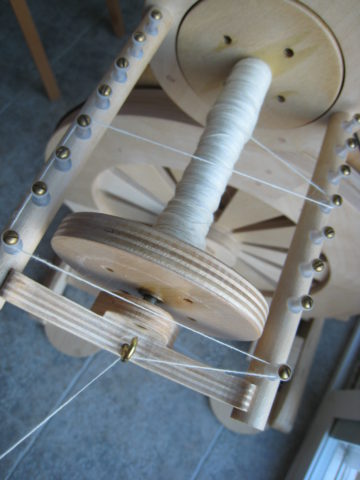I felt the need to post a little overview of how awesome the SpinOlution lazy kate is now that I’ve gotten a chance to give it a test run. I have the Mach 1 spinning wheel and LOVE the look of it as well as how effortless it is to treadle and spin. While the wheel is relatively new to the spinning world, it’s a fast favorite for those of us that have one. I bought mine with two bobbins and finally got around to ordering four more along with the lazy kate from Jessica at Midnight Designs. Jessica was AWESOME through the whole ordering process and was so quick to get back to me – I couldn’t have asked for a smoother transaction. So, if you’re looking for a wheel, fiber, yarn, accessories, check out her store!
Anyway, back to the object of the post – the Lazy Kate from SpinOlution. There are four spots for bobbins and it can either lay flat on the floor or stand up to display what you’ve spun.
To remove a bobbin, push the pegs through to the outside of the kate ‘wall’ and follow the groove in the wood to pull the bobbin up and out.
Those pegs help tension the bobbins and keep them from spinning when they’re not being actively pulled for plying. There is a rod that holds the bobbin with a washer at each end and a plastic spacer to fit into the bobbin end that has the ‘key’ space for fitting in the wheel.
It works like a charm and I couldn’t be happier. Now I just have to finish this spinning project and post that up.. next week, I swear!












 This wheel has pegs at the front that work out perfectly for lacing up the flyer at one point. I took the wool off the bobbin and down along the outside of the row of pegs and then around the front of the right peg and the back of the left peg, coming around to the ‘orifice’ in front. The orifice on this wheel is a big hook instead of a more traditional tube or hole type orifice.
This wheel has pegs at the front that work out perfectly for lacing up the flyer at one point. I took the wool off the bobbin and down along the outside of the row of pegs and then around the front of the right peg and the back of the left peg, coming around to the ‘orifice’ in front. The orifice on this wheel is a big hook instead of a more traditional tube or hole type orifice.